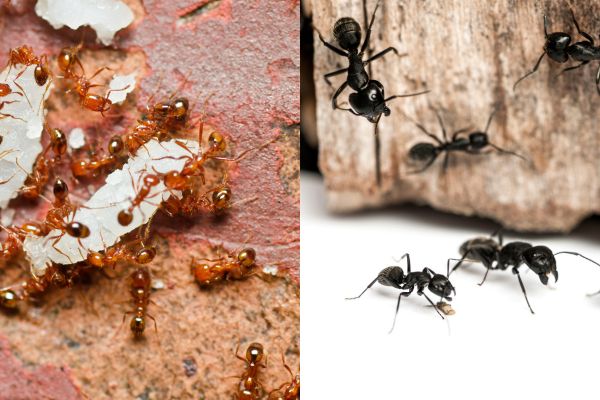Your cart is currently empty!

12 Jul Fire Ants vs Regular Ants: How To Tell The Difference
Ants are fascinating creatures that inhabit various environments around the world. However, not all ants are the same. When it comes to fire ants, their aggressive behaviour and painful stings set them apart from regular ants.
In this article, we will explore fire ants vs regular ants. By delving into their differences, you will gain the necessary knowledge to accurately identify these ant species and make informed decisions on how to handle them effectively.
Physical Appearance:
One of the most evident differences between fire ants and regular ants lies in their physical appearance. Regular ants come in a wide range of species, each with its unique characteristics. On the other hand, fire ants, particularly the red imported fire ant (Solenopsis invicta), have distinct features that set them apart:
1. Colouration: Fire ants exhibit a reddish-brown to reddish-black colouration, with the intensity of red varying among individuals. In contrast, regular ants display a range of colours, including black, brown, yellow, or a combination thereof. The colour variations in regular ants make it challenging to generalize their appearance.
2. Size: Fire ants are relatively small, measuring between 1/8 to 1/4 inch (2-6 mm) in length. Regular ants, however, vary in size depending on the species. Some regular ants may be smaller or larger than fire ants, making size alone an unreliable indicator.
3. Body Structure: Fire ants have a distinct body structure consisting of three main sections: the head, thorax, and abdomen. The head is relatively large, featuring chewing mouthparts, compound eyes, and long, elbowed antennae. The thorax connects the head and abdomen and contains six legs. The abdomen is oval-shaped and attached to the thorax via a slender waist, giving fire ants a segmented appearance. Regular ants may have a similar body structure, but the specific proportions and shape may vary among different species.
Behaviour And Nesting Habits:
Apart from physical characteristics, the behaviour and nesting habits of fire ants and regular ants also differ significantly:
1. Aggression: Fire ants are notorious for their aggressive nature. When a fire ant colony is disturbed or threatened, workers emerge in large numbers, attacking in coordinated swarms. They inflict simultaneous bites and stings, delivering painful venom to their victims. In contrast, regular ants may exhibit defensive behaviours, but their level of aggression is generally much lower than that of fire ants.
2. Nests: Fire ants construct extensive underground nests with distinctive mound structures. These mounds are irregularly shaped and can reach heights of several inches. Regular ants, however, build nests that vary widely depending on the species. Some regular ants create small mounds or burrow into the ground, while others establish nests in trees or structures.
Stings And Venom:
The most notorious characteristic that sets fire ants apart from regular ants is their venomous sting. Fire ants possess a stinger at the rear end of their bodies, which they use to deliver painful stings. The venom of fire ants contains alkaloids, primarily piperidine, which induces intense pain, a burning sensation, and an itchy, raised welt on the skin. In contrast, regular ants do not possess a venomous sting, and their bites are typically less painful and do not cause the same burning sensation.
When encountering fire ants or suspecting their presence, it’s crucial to exercise caution and avoid provoking them. Wearing protective clothing, such as long sleeves, pants, and closed-toe shoes, can minimize the risk of being stung. Additionally, regular inspection and treatment of your surroundings can help manage fire ant colonies and prevent their establishment.
Understanding the differences between fire ants and regular ants is essential for effective pest management and minimizing the risk of painful encounters. By identifying their physical characteristics, behaviour, and nesting habits, you can take appropriate action to protect yourself and your surroundings.
To combat fire ant infestations effectively, Nemaknights Ant Attack offers a powerful and environmentally friendly solution. By repelling and eliminating fire ants, Nemaknights Ant Attack minimizes harm to the environment while ensuring your safety.
Visit the Environmental Factor website to purchase Nemaknights Ant Attack to combat fire ant infestations effectively while prioritizing environmental sustainability.


